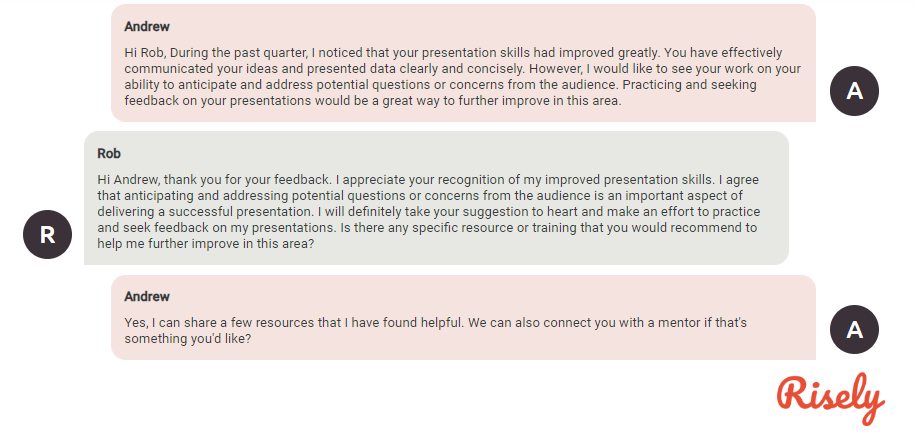10+ Impactful Constructive Feedback Exercises for Managers
Feedback is vital to the success of any organization, and managers are no exception. Managers’ jobs include ensuring employees feel supported, know what’s expected of them, and understand how they can improve as individuals and as a team. Feedback from managers is often aimed at improving the performance of individual employees and ensuring everyone works toward the same goals. Constructive feedback is critical when it comes to feedback from managers to employees. It helps employees understand where they can improve and what they need to work on to reach their goals and career aspirations. But not all feedback is created equal — managers must ensure that the feedback they provide is helpful, actionable, and delivered in a way that empowers employees to improve. Luckily, there are several constructive feedback exercises that managers can do to improve their feedback game. Here’s an extensive list of such constructive feedback exercises for managers to try out (and maybe eventually integrate into their daily routine)!What is constructive feedback?
Constructive feedback is feedback that is positive, actionable, and helpful. It is given on time and specific to the situation. The type of feedback given should be constructive criticism, not criticism or negative feedback.- It is always positive and honest.
- A positive tone of voice is used when giving feedback.
- The person receiving the feedback should be aware of the positive feedback they received.
- Employees should be encouraged to ask for feedback to improve their skills and work performance. This way, they can become more competent and successful at their job.
What is the difference between constructive feedback and criticism?
Constructive feedback and criticism are similar in that they both involve providing feedback on someone’s performance or behavior, but there are some critical differences between them.- Constructive feedback is focused on improvement and intended to help the individual or team grow and develop. It is delivered in a specific, actionable, and respectful way. On the other hand, criticism is often focused on finding fault and pointing out what is wrong. As a result, it can be delivered in a negative, judgmental, and disrespectful way.
- Constructive feedback is typically given in a specific, actionable, and respectful way and includes both positive and negative feedback. Criticism usually needs to come up with a solution or a clear, actionable next step. Often, it’s just pointing out the problem or mistake.
- Constructive feedback helps the individual or team grow and develop, while criticism is often more focused on making the critic feel better.
What are the benefits of constructive feedback?
Constructive feedback can have many benefits, including:- Improving performance: Feedback can help individuals understand what they are doing well and where they need to improve, allowing them to focus on specific areas and make progress.
- Enhancing motivation: Receiving feedback can be motivating, as it shows that others are paying attention to their work and are invested in helping them succeed.
- Facilitating communication: Giving and receiving feedback can help establish open communication lines between individuals and teams, allowing them to work together more effectively.
- Building trust: Giving and constructively receiving feedback can build trust between individuals and teams, showing that everyone is working towards a common goal.
- Promoting self-awareness: Feedback can help individuals understand how their actions and behaviors are perceived by others, promoting self-awareness and personal growth.
Other Interesting Reads
10+ Engaging Constructive Feedback Exercises
Here are some constructive feedback exercises that can be very helpful in promoting a work culture where everyone understands the importance of constructive feedback and support each other in their leaning and growth.Feedback Mad Libs
This exercise is a fun way to practice giving constructive feedback in a low-stakes environment. To start, the manager writes a scenario on a whiteboard or paper and leaves blanks for certain words or phrases that describe a situation where feedback would be necessary. The team or individual then fills in the blanks, and the manager discusses how the input could be framed constructively. This constructive feedback exercise helps managers to understand the importance of preparing feedback in a positive and specific manner, and it also provides an opportunity to practice giving feedback in a supportive and interactive environment.Feedback Through Storytelling
Ask team members to share stories of successful collaboration, communication, or problem-solving within the team. This exercise allows valuable lessons to be learned from real-life experiences.The Feedback Sandwich
This exercise is designed to help managers practice giving positive and constructive feedback. The manager writes down three feedback components: positive, constructive, and positive. The manager then practices giving feedback that follows this structure, with constructive feedback sandwiched between two positive comments. This constructive feedback exercise helps managers to understand the importance of balancing negative feedback with positive reinforcement, and it also provides an opportunity to practice giving feedback in a structured and effective manner. Follow the link to find out more about what is a feedback sandwich !Role-playing
This constructive feedback exercise is an excellent way for managers to practice giving feedback in a realistic setting. The manager and the team members or the individual take turns to play the role of the manager giving feedback and the employee receiving feedback. The manager provides constructive feedback, and the employee practices receiving it professionally. This exercise helps managers understand the importance of clear communication and active listening when giving feedback. It also provides an opportunity to practice giving feedback in a simulated real-world scenario. Risely, the AI coach for leadership development can help you in this exercise as well! With the support of AI bot Merlin, your buddy for growth, you can easily practice scenarios through role-plays. Just define the situation you want to discuss, the moods and tones of the people involved, and get started. Merlin will act as your team member and later help you analyze the conversation, offering helpful suggestions to guide you. Catch a snippet below and sign up for free today to start exploring.
The Feedback Ladder
This exercise is designed to help managers and teams practice giving specific and direct feedback. The manager explains a scenario where a team member needs to provide feedback to another team member. The team members then work together to develop a series of progressively more direct and specific feedback statements, starting with the most indirect and moving up the “ladder” to the most straightforward. This constructive feedback exercise helps managers and teams understand the importance of clear and specific feedback and allows team members to practice giving feedback in a supportive and collaborative environment.Feedback Speed Dating
This constructive feedback exercise is a fast-paced and fun way for managers and teams to practice giving and receiving feedback. The manager sets up a rotation where each team member has time to provide feedback to another team member. The manager facilitates the exercise, ensuring that each person can give and receive feedback. This exercise helps managers and teams understand the importance of clear and concise feedback. It also allows team members to practice giving and receiving feedback in a fast-paced and interactive environment.Strengths Appreciation Circle
Have team members form a circle and take turns sharing each other’s strengths and contributions. This exercise boosts team morale and appreciation while highlighting the diverse talents within the team.Feedback Charades
This constructive feedback exercise is a fun and creative way for managers and teams to practice giving feedback. The manager writes down different feedback scenarios on separate cards, such as “provide constructive feedback on a recent project” or “give praise for a job well done.” The team members then act out the feedback scenario on the card, and the manager discusses how the team members could frame the feedback more constructively. This exercise helps managers and teams understand the importance of clear and creative communication when giving feedback. It also allows team members to practice giving feedback in a fun and interactive environment.Feedback 360
This constructive feedback exercise involves asking team members or colleagues to provide feedback on a manager’s performance. The manager then synthesizes the feedback, determines the areas for improvement, and sets goals for development. This constructive feedback exercise helps managers to understand the importance of seeking feedback from multiple sources. It also allows one to reflect on performance and develop an improvement plan. Read more: A Manager’s Guide to 360-Degree Performance Reviews (with Examples)Feedback Role Reversal
In this exercise, the manager and the team member or individual switch roles, with the manager playing the part of the employee receiving feedback and the employee playing the role of the manager giving feedback. This constructive feedback exercise helps foster empathy and understanding between managers and team members and provides an opportunity to practice receiving feedback in a supportive and non-threatening environment.The Feedback Board Game
Create a board game centered around giving and receiving feedback. Team members take turns rolling dice and moving around the board, landing on spaces that prompt them to share feedback based on specific scenarios or questions.Feedback In A Jar
This constructive feedback exercise involves writing down different feedback scenarios or challenges on separate slips of paper and placing them in a jar. The team members then take turns drawing a slip of paper from the jar and providing feedback on the scenario or challenge written on the slip. This exercise helps managers and teams understand the importance of being prepared and creative when giving feedback. It also allows team members to practice giving feedback in a fast-paced and interactive environment.Feedback Bingo
This exercise involves creating a bingo board with different feedback skills, such as “clear and concise,” “specific and direct,” or “positive and constructive.” The manager then facilitates a game of feedback bingo, with each team member taking turns giving feedback to another team member. The team member who receives the feedback checks off the corresponding feedback skill on their bingo card. This constructive feedback exercise helps managers and teams understand the importance of using various feedback skills. It also allows team members to practice giving and receiving feedback in a fun and interactive environment.Two Stars and a Wish
Team members take turns sharing two positive aspects (stars) and one area for improvement (wish) about a recent project or presentation. This exercise promotes a balanced view of performance and encourages constructive feedback.Tips to help your feedback make a positive impact
- When providing feedback, it is essential to be clear and concise.
- To avoid offending your employee, use the correct language to ensure the feedback is constructive.
- It is also important not to give feedback in one big chunk; instead, break it into smaller pieces to better understand the behavior.
- Feedback should be given immediately after the incident occurs. This allows the recipient time to think about the feedback, work on the suggested improvements, and develop a plan for making those improvements.
- Managers should avoid giving judgmental, condescending, or accusatory feedback. Instead, they should provide feedback using positive words and phrases, and examples relevant to the issue being addressed.
- It is often best to give feedback gradually, allowing time for your employee to improve over time. This will allow them to absorb and incorporate the feedback without being overwhelmed by it all at once.
- It is essential to listen carefully to what your employee has to say before giving feedback. This will help you gather valuable information about the behavior you are describing and the impact of that behavior on the team or organization as a whole.
- Finally, plan how you will follow up on the feedback you give. This will help ensure that your feedback has been effective.
Resource Buckets for you!
- 5 Easy & Fun Icebreaker Office Games For Teams
- 5 Fun and Effective Expectation Setting Activity For All Managers
- 5 Best Problem-Solving Activities To Build A Successful Team
- 7 Engaging growth mindset activities for professional development
Conclusion
In addition to demonstrating empathy, feedback is a powerful tool for enhancing performance and fostering a positive work environment. Feedback should always be positive, specific, and actionable. Feedback is given frequently, consistently, and in a way that allows recipients to understand and act on it. These constructive feedback exercises provide a fun and engaging way for managers and teams to improve their skills in giving constructive feedback. By practicing in a supportive and low-stakes environment, managers and teams can develop the confidence and competence necessary to provide effective and impactful feedback in the real world.Unlock more resources with a free copy of the constructive feedback toolkit for managers
The constructive feedback toolkit offers statements and frameworks simplifying constructive feedback for managers
Other Related Blogs
Assertive Feedback Techniques ft. Gurleen Baruah
Assertive Feedback Techniques ft. Gurleen Baruah Let’s be real—giving feedback as a manager isn’t always easy. Say too little, and nothing changes. Say too much, and it might come off…
How to ask for feedback from employees? | Gurleen Baruah
How to ask for feedback from employees? | Gurleen Baruah Feedback is a two way street. This podcast took managers on a trip down the other side. As managers, we…
How to give a constructive feedback? | Gurleen Baruah
How to give a constructive feedback? | Gurleen Baruah Giving constructive feedback to help the team achieve more is one of the primary tasks of a manager. But, without the…
Let’s Reverse the Gaze of Radical Candor?
Let’s Reverse the Gaze of Radical Candor? Have you heard about Radical Candor? It’s a book by Kim Scott that first came out in 2017. The tagline is “Caring Personally…


